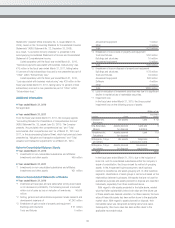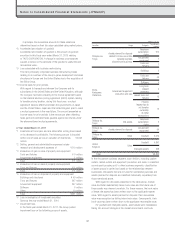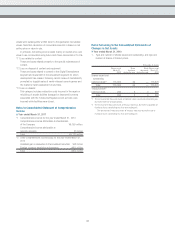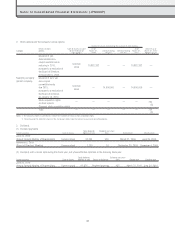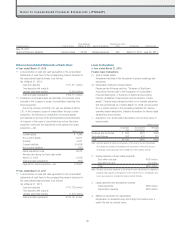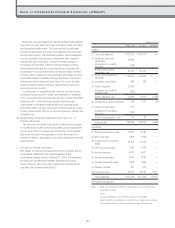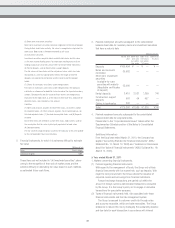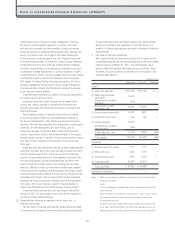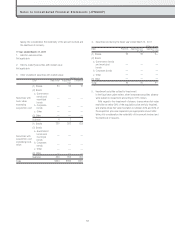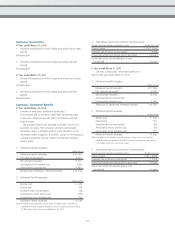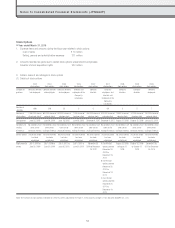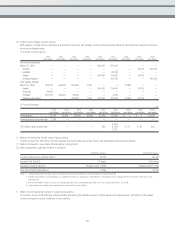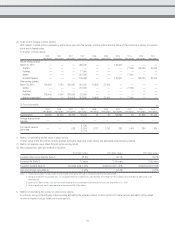Square Enix 2011 Annual Report Download - page 52
Download and view the complete annual report
Please find page 52 of the 2011 Square Enix annual report below. You can navigate through the pages in the report by either clicking on the pages listed below, or by using the keyword search tool below to find specific information within the annual report.
rules at each Group company for sales management. Owing to
the Group’s global business operations, a portion of its notes
and accounts receivable are denominated in foreign currencies,
which are exposed to exchange rate fluctuation risk. Although the
Group, in principle, does not engage in derivative transactions,
for the purpose of hedging against the risk of future fluctuations
in foreign-exchange rates, it enters into forward foreign exchange
contracts from time to time. Although forward foreign exchange
contracts involve exposure to exchange rate fluctuation risk, each
counterparty to these transactions is, without exception, a highly
creditworthy bank. Hence, the Group judges that credit risk through
counterparty breach of contract (counterparty risk) is negligible.
With regard to forward foreign exchange transactions, all risk is
centrally managed by the accounting division under the approval
of a representative director and the director assigned to oversee
accounting and finance matters.
Corporate taxes receivable is a refund of corporate taxes that is
recouped in a short period of time.
Investment securities mainly comprise stock market listed
shares, and, hence, exposed to market price fluctuation risk.
However, fair values are monitored and regularly reported to the
Board of Directors.
Rental deposits consist of deposits required to be furnished
by the Group when it enters into real estate leases relating to
the Group’s headquarters, other offices and amusement arcade
facilities. Although these deposits involve exposure to counterparty
credit risk, for the headquarters and other offices, and for
amusement arcades, the general affairs division and the sales
division, respectively, confirm the creditworthiness of the lessors
through regular contact. In addition, the accounting division checks
with each of these divisions on the situation at the end of each
fiscal year.
Notes and accounts payable are defined as those trade payables
due within one year. Short-term loans are used to meet short-term
working capital requirements. The Group avoids the settlement
liquidity risk associated with short-term payables, including notes
and accounts payable, accrued corporate taxes and short-term
loans, through the monthly review of its funding plan and other
methods. Although foreign currency-denominated trade payables
involve exposure to exchange-rate fluctuations, the Group reduces
this risk through similar methods to those used to manage the risk
associated with foreign currency-denominated trade receivables.
Although the Group is exposed to interest-rate risk through short-
term loans. The Group, however, is able to respond flexibly to
interest rate fluctuations since the borrowing periods are short.
Corporate bonds comprise euro yen zero-coupon convertible
bonds due 2015. As zero-coupon bonds, they are not exposed to
the risk of interest rate fluctuations.
(3) Supplementary information regarding the fair value, etc., of
financial instruments
The fair value of financial instruments includes amounts based
on market prices as well as those calculated using an appropriate
formula when there is no applicable market price. Since variable
factors are included in the calculation of such fair values, the
adoption of different assumptions may lead to changes in these fair
value amounts.
2. Fair value of financial instruments
With regard to financial instruments held by the Company and its
consolidated subsidiaries, the values presented on the consolidated
balance sheet as of March 31, 2011, the estimated fair value
and the difference between these amounts are as follows. Items
for which fair value is difficult to estimate are not included in the
following table (Note 2).
Millions of yen
Book value Fair value Difference
Assets:
(1) Cash and deposits ¥111,126 ¥111,126 ¥ —
(2) Notes and accounts
receivable 15,474
Allowance for doubtful
accounts (119)
Notes and accounts
receivable, net 15,354 15,354 —
(3) Income taxes receivable 6,907 6,907 —
(4) Investment securities 334 334 —
(5) Rental deposits 12,316
Allowance for doubtful
deposits paid (526)
Rental deposits, net 11,790 11,335 (455)
Total assets 145,513 145,058 (455)
Liabilities:
(1) Notes and accounts payable 7,777 7,777 —
(2) Short-term loans 1,338 1,338 —
(3) Accrued income taxes 2,269 2,269 —
(4) Corporate bonds 35,000 35,000 —
Total liabilities ¥ 46.386 ¥ 46.386 ¥ —
Derivative transactions ———
Notes: 1. Matters concerning the methods for estimating fair value and short-term
investment securities
Assets
(1) Cash and deposits, (2) Notes and accounts receivable and (3) Income
taxes receivable
Since these items are settled on a short-term basis, book value is used on
the assumption that fair value is principally equivalent to book value.
(4) Investment securities
Investment securities comprise stock market listed shares and fair value
is the stock-market trading price. For information relating to each of the
holding purposes of securities, please refer to the note titled “Securities.”
Notes to Consolidated Financial Statements (JPNGAAP)
50



